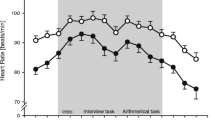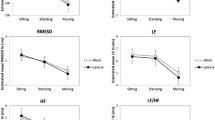Abstract
Physiological responses serve the role as objective indicators of stress as well as a link between psychosocial stress and various health outcomes. The aim of the present exposure session was to compare different physiological stress responses (systolic and diastolic blood pressure, heart rate, urinary epinephrine and norepinephrine, salivary cortisol) as well as trapezius muscle activity, measured by surface electromyography, during mental and physical stress in 11 women and ten men. The results show significantly increased activity in all measures but cortisol and significant associations between sympathetic arousal and EMG activity. The association between sympathetic arousal and muscle activity is of importance for understanding the high prevalence of musculoskeletal disorders in mentally stressful but physically light work tasks. Men had higher blood pressure and a more pronounced increase in epinephrine output than women, whereas women had higher heart rate. It was concluded that sympathetic activity is more sensitive to moderately intense stress exposure than pituitary adrenocortical (cortisol) activity and that men respond to performance stress with more epinephrine output than women. Although the correlations between the different indicators of sympathetic arousal were high, together they could still only explain 30–70% of the inter-individual variance. Thus, several parameters are needed in order to obtain a reliable measure of sympathetic activity.
Similar content being viewed by others
References
Alehagen, S., Wijma, K., Lundberg, U., Melin, B., & Wijma, B. (2001). Catecholamine and cortisol reaction to child birth.International Journal of Behavioral Medicine, 8, 50–65.
Das, D.K. (1999). Hearts in Stress.Annals of the New York Academy of Sciences, Vol. 874.
Fink, G. (Ed.) (2000).Encyclopedia of stress. Volume 1–3. San Diego: Academic Press.
Frankenhaeuser, M., Dunne, E., & Lundberg, U. (1976). Sex differences in sympathetic adrenal medullary reactions induced by different stressors.Psychopharmacology, 47, 1–5.
Frankenhaeuser, M. (1983). The sympathetic-adrenal and pituitary-adrenal response to challenge: comparison between the sexes. In T.M. Dembroski, T.H. Schmidt, G. Blümchen (Eds.),Biobehavioral bases of coronary heart disease. Basel: New York, Karger, pp. 91–105.
Frankenhaeuser, M., Lundberg, U., & Chesney, M. (Eds.). (1991).Women, work, and stress. New York: Plenum Press.
Frankenhaeuser, M., Lundberg, U., & Forsman, L. (1980). Dissociation between sympathetic-adrenal and pituitary-adrenal responses to an achievement situation characterized by high controllability: comparison between Type A and Type B males and females.Biological Psychology, 10, 79–91.
Hjemdahl, P., Larsson, P.T., Bradley, T., Åkerstedt, T., Anderzén, I., Sigurdsson, K., Gillberg, M., & Lundberg, U. (1989). Catecholamine measurements in urine by high- performance liquid chromatography with amperometric detection-comparison with an auto-analyzer fluorescence method.Journal of Chromatography, 494, 53–66.
Hägg, G. (1991). Static work loads and occupational myalgia—a new explanation model. In: Anderson P.A., Hobart D.J., Danhoff, J.V., editors. Electromyographical Kinesiology. Amsterdam: Elsevier Science Publishers BV; p. 141–144.
Jonsson, B. (1978). Kinesology. With special reference to electromyographic kinesology. In: W.A. Cobb, H. Van Duijn (Eds.),Contemporary Clinical Neurophysiology. EEG Suppl. 34, pp. 417–428.
Kirschbaum, C., & Hellhammer, D. (1989). Salivary cortisol and psychobiological research: an overview.Neuropsychobiology, 22, 150–169.
Krantz, G., & Östergren, P-O. (2001). Double exposure: the combined impact of domestic responsibilities and job strain on common symptoms in employed Swedish women.European Journal of Public Health, 1, 413–419.
Lovallo, W.R. (1997). Stress and health. Biological and psychological interactions. Sage Publications.
Lundberg, U., Holmberg, L., & Frankenhaeuser, M. (1988). Urinary catecholamines: Comparison between HPLC with electrochemical detection and fluorophotometric assay.Pharmacology, Biochemistry, and Behavior, 31, 287–290.
Lundberg, U. (1999). Coping with stress: neuroendocrine reactions and implications for health.Noise and Stress, 4, 67–74.
Lundberg, U., Forsman, M., Zachau, G., Eklöf, M., Palmerud, G., Melin, B., & Kadefors R. (2002). Effects of experimentally induced mental and physical stress on motor unit recruitment in the trapezius muscle.Work & Stress, 16, 166–178.
Lundberg, U. (1996). The influence of paid and unpaid work on psychophysiological stress responses of men and women.Journal of Occupational Health Psychology, 1, 117–130.
Lundberg, U., de Château, P., Winberg, J., & Frankenhaeuser, M. (1981). Catecholamine and cortisol excretion patterns in three-year-old children and their parents.Journal of Human Stress, 7, 3–11.
Lundberg, U., & Forsman, L. (1980). Consistency in catecholamine and cortisol excretion patterns over experimental conditions.Pharmacology, Biochemistry, and Behavior, 12, 449–452.
Lundberg, U., Hansson, U., Andersson, K., Eneroth, P., Frankenhaeuser, M., & Hagenfeldt, K. (1983). Hirsute women with elevated androgen levels: psychological characteristics, steroid hormones and catecholamine.Journal of Psychosomatic Obstetrics and Gynaecology, 2, 86–93.
Lundberg, U., Kadefors, R., Melin, B., Palmerud, G., Hassmén, P., Engström, M., & Elfsberg Dohns, I. (1994). Psychophysiological stress and EMG activity of the trapezius muscle.International Journal of Behavioral Medicine, 1, 354–370.
Lundberg, U., Melin, B. (2002). Stress in the development of musculoskeletal pain. In S. Linton (Ed.), Avenues for the Prevention of Chronic Musculoskeletal Pain and Disability. Elsevier Science, pp. 165–179.
McEwen, B.S. (1998). Protective and damaging effects of stress mediators.New England Journal of Medicine, 238, 171–179.
McEwen, B., & Lasley, E.N. (2002).The end of stress as we know it. Joseph Henry Press, Washington D.C.
Rodin, J., & Ickovics, J.R. (1990). Women's health. Review and research agenda as we approach the 21st century.American Psychologist, 45, 1018–1034.
Rozanski, A., Bairey, C.N., Krantz, D.S., Friedman, J., Resser, K.J., Morell, M., Hilton-Chalfen, S., Hestrin, L., Bietendorf, J., & Berman, D.S. (1988). Mental stress and the induction of silent myocardial ischemia in patients with coronary artery disease.The New England Journal of Medicine, 318, 1005–1011.
Schneiderman, N., Weiss, S., & Kaufmann, P. (1989). Handbook of research methods in cardiovascular behavioural medicine. New York: Plenum.
Sjøgaard, G., Lundberg, U., & Kadefors, R. (2000). The role of muscle activity and mental load in the development of pain and degenerative processes on the muscle cellular level during computer work.European Journal of Applied Physiology, 83, 99–105.
Steptoe, A. (1991). The links between stress and illness,Journal of Psychosomatic Research, 35, 633–644.
Stroop, J.R. (1935). Inference in serial verbal reactions.Journal of Experimental Psychology, 18, 643–661.
Svebak, S., Anjia, R., & Kårstad, S.I. (1993). Task-induced electromyographic activation in fibromyalgia subjects and controls.Scandinavian Journal of Rheumatology, 22, 124–130.
Turner, J.R. (1994).Cardiovascular Reactivity and Stress. Patterns of Physiological Response. New York and London: Plenum Press.
Wamala, S., Lynch, J. (2002).Gender and Social Inequalities in Health. Stockholm: Studentlitteratur.
Wærsted, M. (1997). Attention-related muscle activity—a contributor to sustained occupational muscle load. Doctoral dissertation, National Institute of Occupational Health, Oslo, Norway.
Westgaard, R.H., & Winkel, J. (2002). On occupational ergonomic risk factors for musculoskeletal disorders and related intervention practice. In S. Linton (Ed.),Avenues for the prevention of chronic musculoskeletal pain and disability. Elsevier Science, pp. 143–164.
Author information
Authors and Affiliations
Corresponding author
Rights and permissions
About this article
Cite this article
Krantz, G., Forsman, M. & Lundberg, U. Consistency in physiological stress responses and electromyographic activity during induced stress exposure in women and men. Integr. psych. behav. 39, 105–118 (2004). https://doi.org/10.1007/BF02734276
Issue Date:
DOI: https://doi.org/10.1007/BF02734276




